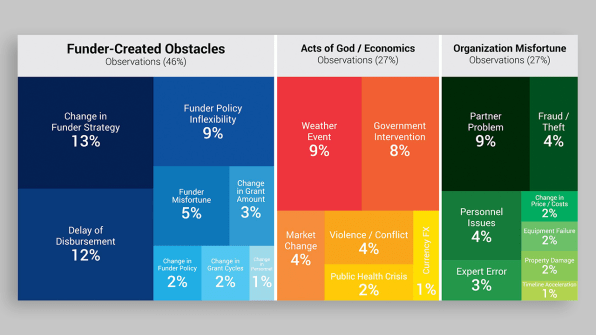How Funders Often Hurt The Nonprofits They Are Trying To Help
Nonprofits face a lot of unexpected threats when trying to make change in the world. But they’re common enough to be categorical. One typically gets filed under acts of god, when some outside factor like, say, a surprise mega-storm decimates all of the crops that hunger-relief organizations depend on. Or a government destabilizes, or currency in a region becomes devalued.
Another can be chalked up to organizational misfortune: That’s when some partner group–say, a community organization or local government that promised to help implement some health reform–can’t pull off its part of the deal. Basic fraud or theft fall under this umbrella too, along with employee illness or warehouse fires.
But the biggest, and perhaps most surprising bucket of despair, is created by the very people who are trying to help. When an organization bankrolling positive change accidentally torpedoes it by changing their funding strategy mid-grant cycle, delaying disbursement of funds for some reason, or being generally inflexible in how they dole out money that generally cash-strapped groups depend on. Call them “funder-created obstacles.”

These findings, and the terms, come from Open Road Alliance, which provides bailout grants to groups that encounter unexpected, mission-crippling obstacles. The group, which has been offering charitable or recoverable grants since 2012, has also been tracking exactly what led groups to seek its services. The result is their newly released “Roadblock Analysis Report” that tracks 102 applications with 22 distinct problems, all of which fall into one of those three boarders areas of concern.
Overall, Funder-Created Obstacles accounted for 46% of nonprofit difficulties, followed by Act of God/Economics and Organizational Misfortune, which tied at 27% each, in terms of total reported problems. “The implications of this analysis are sobering, because this data suggests that the biggest barrier to effective impact and the greatest pain point for nonprofits and social enterprises are their own funders,” notes the report. “We have become our own enemy in the pursuit of impact and return on investment.”
The main culprit appears to be entrenched levels of bureaucracy. “[E]fforts to professionalize our own work through increased policy and procedure and efforts to ensure fiscal accountability through restricted grants have unintended, harmful consequences that we now are seeing.”
Only 20% of grants made in the U.S. are unrestricted, meaning most come with earmarks for where and how the money can be used, along with a timetable for when the money is released. It’s a funder-dictated relationship, and often one-sided, because groups that are reliant on funding don’t want to express dislike for some terms, lest they upset those doling out the cash. (That’s changing a bit, as Yelp-like review sites like GrantAdvisor allow groups better rate their experiences.)
But as the report notes, funders are traditionally bad at sharing hugely important information, too. Changes in funding strategy, for instance, are often downplayed–until the organization is notified that funding it has relied on will suddenly be revoked. The same is true in changes of distribution delays. The report recommends more transparency and candor on both sides of the organization.
Open Road Alliance has already documented the logic of providing stopgap funding to save otherwise well-performing groups from random acts of destruction. In early 2017, the initial $7.6 million that it distributed among more than 50 groups saved about seven times that in total investment, along with helping those nonprofits to continue work that was radically improving and often just plain saving lives. It’s a strategy that’s also expanding: By early 2018, the group had nearly doubled its distribution total, along with launching a low-interest loan fund expected to deliver another $50 million to nonprofits over the next half-decade.
While it may be harder to control for storms decimating crops or an on-the-ground partners not implementing the expected services, groups that consider themselves most vulnerable to Acts of God or Organizational Misfortune camps could consider that their first mistake. The top three most common types of cause groups seeking Open Road Alliance aide were health, agricultural and education groups. All three camps–and obviously many more–were most affected by funder failures.
(18)



